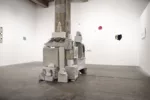Twenty distinguished artists were asked an “either/or” question: “Is the sun rising or setting on the experiment of American democracy?” Their profound responses from multiple viewpoints deny the limitations of “either/or” questions. The result of this curatorial prompt is now a thrilling and complex exhibition.
Conceived in 2016 by Jodi Throckmorton, former Curator of Contemporary Art at Pennsylvania Academy of the Fine Arts (PAFA), Rising Sun: Artists in an Uncertain America refers to Benjamin Franklin’s contemplation of the sun carved in George Washington’s chair during the Constitutional Convention in 1787, and a line from NAACP leader James Weldon Johnson’s “Lift Ev’ry Voice and Sing,” written in 1900. The location of Rising Sun in center city Philadelphia, where the founding documents of our country were hammered out by white males, adds to the exhibition’s significant impact.
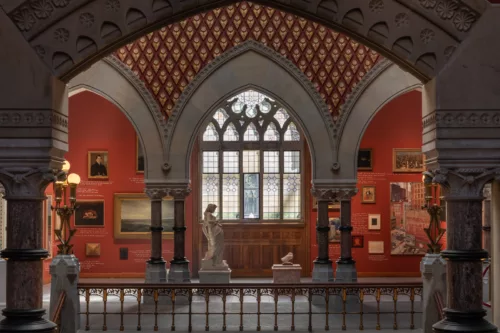
At each location, the Rising Sun artists make inspired use of existing spaces and ongoing exhibitions. Demetrius Oliver’s four works at the African American Museum (AAMP) are installed to seamlessly magnify, aesthetically and conceptually, the permanent Audacious Freedom display. At PAFA, Lenka Clayton’s The True Story of a Stone is a superb arrangement curated by the artist, who drew from PAFA’s permanent collection and incorporates the gallery space itself into the narrative.
AAMP’s four-level open space and long ramps allow sights and sounds to blend from one artist’s work to the next. La Vaughn Belle’s panoramic video, Between the Dusk and Dawn (how to navigate an unsettled empire), plays on a continuous loop on the ramp-facing wall. The narratives from Audacious Freedom can be heard throughout, mingling with Deborah Willis’s Facing the Rising Sun. Willis’s work, an installation of archival photographs of Black Civil War soldiers and related ephemera, includes a haunting video of dancers performing to Joan Baez’s song, “Civil War.” From around the corner, the sounds of people shouting in John Akomfrah’s three-channel video, Triptych (2020), add an eerie counterpoint to Joan Baez’s mournful voice.
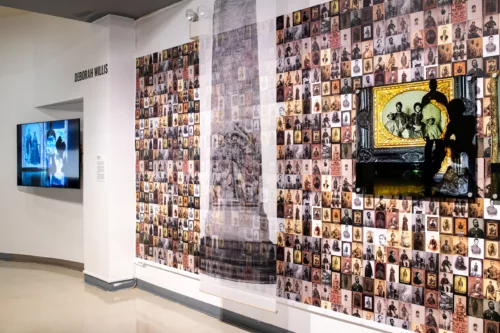
Dread Scott’s four pigment prints, stills from Slave Rebellion Reenactment, show scenes of Scott leading 300 people on a 24-mile march in 2020, retracing the route taken in 1811 by Charles Deslondes and his followers in the German Coast Rebellion. The images of insurrection and spontaneous celebration are moving and unforgettable. Across from Scott’s works, Renée Stout’s Sketchbook, With Foreboding is particularly arresting: first created in 2017, the work depicted large-scale notes, sketches, and project plans, but in 2019 the artist was moved to paint a fiery explosion across the panel’s surface, obscuring the images beneath.
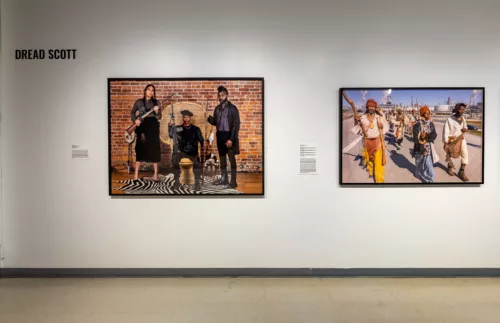
Rising Sun’s curators—Dejay Duckett, Vice President of Curatorial Services (AAMP); Judith Tannenbaum, Project Curator (PAFA); Mekhala Singhal, Curatorial Fellow (PAFA); Michael K. Wilson, Curatorial Fellow (AAMP); and contributors Throckmorton and Juan Omar Rodriguez, Curatorial Fellow at PAFA—emphasize that although Rising Sun is installed in two venues, it is a single exhibition. While the museums’ interiors are different in design and atmosphere, the show feels cohesive, partly because each artist’s work (with a few exceptions) is displayed within a dedicated gallery space.
Seven blocks west, up Arch Street from AAMP, the ornate museum interior at PAFA exudes a solemnity somewhat disrupted and lightened by Rising Sun. Huge works, like Eamon Ore-Giron’s magnificent hard-edge abstract paintings on linen, Black Medallion XIV (Inti) and Black Medallion XV (Mama-Quilla), dominate the halls above the central stairs. Other artists’ works deftly interact with PAFA’s skylights, and Saya Woolfalk’s gorgeous multimedia installation, We Emerge at the Sunset of Your Ideology, makes full use of the soaring, cathedral-like space in the central hall. In a “Connecting Past and Present” gallery, a replica of George Washington’s chair with its rising (or setting) sun emblem is surrounded by works chosen from PAFA’s permanent collection. Searing paintings by Mary Whitfield and collages by Theodore A. Harris seem to reproach the chair itself, as a symbol of violent oppression.
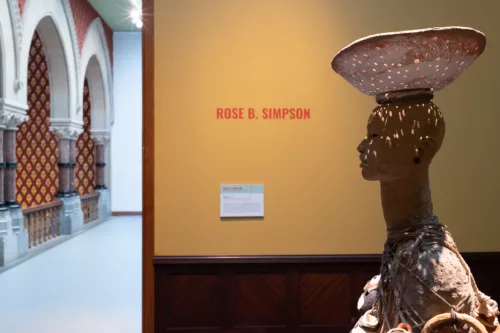
Installed alone in a room at PAFA, Rose B. Simpson’s Delegate strikes a resounding chord. A ceramic human figure with a long neck and no arms, the impassive sculpture is burdened by at least 25 ceramic jugs suspended by twine slung around its neck. Does each jug symbolize an injustice, a message, or sustenance for the delegate on its journey? Where was the delegate sent, and were the doors locked when it arrived? It takes nerve to stand in front of this piece, carrying its jars and wearing a hat full of stars, and face its gaze. The shallow bowl on its head is pierced with holes, strewing little spots of light from above onto its forehead. The patterns of light lengthen as they slide down the figure’s face, forming the shapes of tears.
Rising Sun’s magnitude is overwhelming—in a good way—and people may want to visit more than once and bring their families. AAMP will offer free admission on Juneteenth, with the hope that more free or pay-as-you-wish days will be announced at both venues.
For information about Rising Sun, the participating artists, and how to buy joint admission tickets (at a discount) to both venues, visit risingsunphilly.org. AAMP is located at 701 Arch St., Philadelphia. (215) 574-0380 or aampmuseum.org. PAFA: 118-128 N. Broad St., Philadelphia. (215) 972-7600 or pafa.org.





